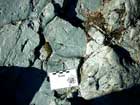
..Main
Menu - Geological Periods - Ordovician
 |
||
|
..Main
Menu - Geological Periods - Ordovician
|
Ordovician 510-440 Ma ( Arran at 15 degrees N)
Caught up in the collision between two ancient island arcs and Laurentia are the suspected remnants of an ancient ocean floor, thought to be represented on Arran by a thin band of submarine shales and volcanics of Ordovician age. During the Ordovician, the Iapetus Ocean was starting to close, and the effect was to bring ever closer the southern parts of Britain to where its northern half lay: the edge of the Laurentian continent. A particular event, the Grampian Orogeny, saw volcanic island arcs (Midland Valley of Scotland) accreted to the passive margin of Laurentia as a consequence of oceanic plate subduction. Known
collectively as the North Glen Sannox Beds, this sequence of rocks outcropping
in the North Sannox Burn comprise pillow lavas (see image on left), agglomerates,
and shales with nodules of radiolarian chert. These rocks are sandwiched
between the older Dalradian rocks to the west and the younger conglomerates
to the east which are associated with the Midland Valley Terrane. The divide
between the Dalradian and North Glen Sannox Beds is essentially that which
separates the highlands from the lowlands in Scotland; an ancient weakness
in the crust known as the Highland Boundary Fault, which can be traced from
Arran to Stonehaven. Known
collectively as the North Glen Sannox Beds, this sequence of rocks outcropping
in the North Sannox Burn comprise pillow lavas (see image on left), agglomerates,
and shales with nodules of radiolarian chert. These rocks are sandwiched
between the older Dalradian rocks to the west and the younger conglomerates
to the east which are associated with the Midland Valley Terrane. The divide
between the Dalradian and North Glen Sannox Beds is essentially that which
separates the highlands from the lowlands in Scotland; an ancient weakness
in the crust known as the Highland Boundary Fault, which can be traced from
Arran to Stonehaven.
|
||||||||||||||||||||||||||||||||
| INDEXES REFERENCES ACKNOWLEDGEMENTS |
|
Search:
|
| University
of Glasgow
|